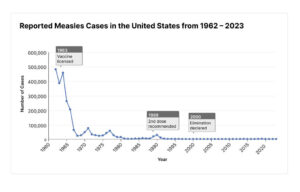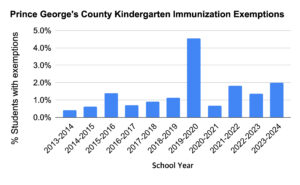This month two cases of measles have been confirmed in Prince George’s County. This is not necessarily an outbreak, however, because to be considered such there need to be three or more related cases. The two cases in Prince George’s County arose in individuals who had travelled internationally, returning through Dulles International and Reagan National Airports on March 14. In addition, there was also a recent confirmed case in Howard County, also a person who had travelled internationally, and on Tuesday this week a case was confirmed in Washington, D.C.
Measles Hits PGCPS
On Thursday, March 20, parents of children who attend Prince George’s County Public Schools (PGCPS) received an email from Superintendent Millard House II informing them of the confirmed case of measles within PGCPS. The confirmed case was at John Hanson Montessori, but the email came eight days after the last known exposure there, which oc-curred on March 12. The specialty Montessori school is located in Oxon Hill and serves students from pre-k to eighth grade.
In his email, House noted measles cases are rising nationwide and said the school district “is working closely with the Prince George’s County Health Department to monitor and respond to any local impact.”
According to data from the Centers for Disease Control (CDC), nationwide there were 285 measles cases reported in 2024 but by March 20, 2025, there have already been a total of 378 confirmed measles cases in the U.S. this year.
Also Battling Flu
The measles case was announced just two weeks after PGCPS announced two students had died from flu (see the March 13 issue). “While measles is a serious concern, it is not the only health risk we are currently facing,” noted House. “We remain in the midst of flu season and as you may be aware, our community has recently experienced two flu-related deaths. This serves as a sobering reminder of the importance of protecting our health and taking steps to prevent the spread of illness.”
Need for Vaccination

House’s March 7 email called vaccination an “important step” in keeping schools safe and his March 20 message called it “critical.” “Those who have been vaccinated for Measles (MMR) are at very low risk. However, unvaccinated individuals face a much higher risk of infection. As a precaution, any unvaccinated student or staff member at a school with a confirmed case will be excluded from in-person learning or work until 21 days after the last confirmed case,” stated the superintendent’s message.
PGCPS is currently conducting enhanced cleaning and disinfecting, calling on parents to keep sick children at home, practice hand washing and hygiene and keep children up to date with vaccinations.
Drop in Vaccinations
According to the CDC, when more than 95 percent of people in a community are vaccinated, “most people are protected through community immunity (herd immunity).” However, nationwide data shows “coverage among U.S. kindergartners has decreased from 95.2 percent during the 2019-2020 school year to 92.7 percent in the 2023-2024 school year, leaving approximately 280,000 kindergartners at risk during the 2023-2024 school year.”

Vaccination coverage in Maryland looks better than the national average. Maryland state law requires that students receive “age appropriate vaccinations,” which include the MMR vaccine. However, the state allows for possible exemptions to vaccine requirements – the most commonly used one is the religious exemption. The number of children in the state and in the county who utilize exemptions to vaccination has risen in recent years and spiked during Covid, according to data from the Maryland Department of Health Center for Immunization. For the 2023-2024 school year 0.66 percent of kindergartners in Prince George’s County were unvaccinated for medical reasons and 1.33 percent were unvac-cinated with a religious exemption, meaning 2 percent of the 98.1 percent of students surveyed were unvaccinated. We can compare those rates to 20 years ago and see that in the 2003-2004 school year the number of kindergartners with medical exemptions in the county was 0.1 percent and those with religious exemptions made up 0.2 percent. Similarly, a decade ago exemptions remained low for the 2013-2014 school year with still only 0.1 percent of kindergartners having a medical exemption and 0.3 percent a religious exemption in Prince George’s County. The number of unvaccinated students was already rising but spiked during Covid, with a total of over 4.5 percent of kindergartners using exemptions for the 2019-2020 school year.
Though there have been three confirmed cases of measles in Maryland this month alone, high rates of vaccination should prevent an outbreak in the state of the kind currently seen in Texas and New Mexico.
Measles symptoms include a high fever, cough, runny nose, sore throat and red, watery eyes. The rash it’s commonly associated with often takes approximately five days to de-velop. Those most at risk from the highly contagious virus are the unvaccinated, including babies.



